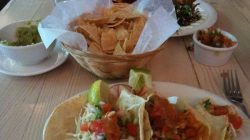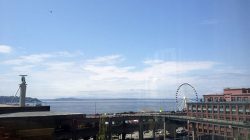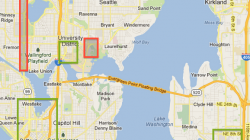I have been meaning to write a series of posts like this for a while. With guests on the way for our wedding this summer, and the possibility I may eventually move for a new job, it seems like a good time to finally git ‘er done.
Seattle was actually my first trip that took advantage of any nascent travel hacking skills, though nothing I did back then could really qualify as such. I flew between SJC and SNA often enough for college that I had a free ticket on Southwest. One Christmas break I decided to escape the family drama and head to Seattle for a few days. I soon learned why hotels are and award space are so plentiful in the winter…
I booked a room on the 12th floor of the Crowne Plaza using Hotwire for $79 a night and took the bus from the airport. I was horribly underdressed and unaccustomed to finding food anywhere but my familiar suburban chain restaurants. The only thing that made up for an otherwise miserable trip was the thrill of being on my own for the first time. And that’s what got me hooked on travel.
No longer did I have to worry about where my mom or dad wanted to take us, when others’ schedules were open, or whether the group voted for the city or the beach. I could just get up and go wherever I wanted as long as I found a good price, so I set about learning how to find such deals. But that’s a story for another day.
My point in writing this series is to introduce a truly amazing city that sometimes gets ignored for being tucked away in a sparsely populated corner of our nation. I’m not sure I want to live here all my life, but I definitely hope to visit often should I ever move away.
Weather
I moved up here for my graduate studies after complaining about the boring sunshine and sterile culture of Southern California. Now I get to complain about the constant drizzle. It actually doesn’t rain much in Seattle, but it is at a slow and steady rate (“Seattle spittle”) such that it’s rare for things to completely dry out. So strike that rumor.
What is true is that we sell a lot of sunglasses. The extreme latitude means the sun is almost always near the horizon. In the summer, we can get almost 17 hours of sunshine, but “summer” is defined as anything over 70 degrees, at which point people start to complain about the oppressive heat. Usually July 5th is the official start, and summer can be truly gorgeous, but it’s not uncommon for me to wear a light coat on a grey August day.
Traffic
One of the hardest adjustments to Seattle life, besides the weather, is the traffic. I grew up on the streets and highways of suburban California. There was a surface road near my undergraduate university with a posted speed limit of 55 miles per hour. In most of Seattle, speed limits are 35 mph for commercial areas and 25 mph for residential areas. The highway limit is 60 mph. And people generally follow these guidelines or go even slower.
It’s for good reason. Most roads are poorly maintained, and any residential areas are narrow with parking on both sides and one lane in the middle shared by cars going both directions. That’s why cars will park facing the wrong direction on the opposite side of the street; it doesn’t really matter. Unfortunately, people’s caution in some areas is countered by complete stupidity in others.
Despite driving slower than the posted speed limit, when someone wants to turn left and yields, cars behind them will do the “Seattle swerve” and go around. I swear I never saw this in California. There are many traffic circles and stop signs where people will wait and wait, always refusing to take their turn. Good luck if you find yourself at one of the many five-way stops. Pedestrians generally don’t jaywalk at intersections, waiting patiently for the crossing signal to change, but outside of busy areas they seem to enjoy dressing in black and darting out from behind parked cars at night.
Culture
If you look at the United States at night, the Pacific Northwest is a big dark spot. We have Vancouver and Portland nearby, but otherwise it’s a whole lot of trees and smaller cities. Seattle is one of the biggest, though it feels like a collection of independent neighborhoods, each a cluster of homes surrounding one or two commercial streets. They act that way, too. Ballard still has signs and T-shirts declaring “Free Ballard” despite merging with Seattle over 100 years ago. Many cars in my neighborhood sport bumperstickers that say “Maple Leaf 4 Life.”
I happen to love the small neighborhoods. For all its faults, Maple Leaf is a great place to call home, with my friendly neighborhood Ace a few blocks away, next door to Reckless Video. The Roosevelt Ale House is a place where people can take their kids, and Cafe Javasti, next door to my former apartment, has some of the best coffee and pastry in the city (it’s hard to find both in one place). I like the bar scene in Capitol Hill, the great restaurants in Ballard, and eating Red Mill burgers on Phinney Ridge with a view of Green Lake.
Some who come here from out of state will complain about the prices (and a good hotel generally does cost a lot in the summer), but most restaurants and activities offer surprising value to someone like me raised in the Bay Area. Chain restaurants are relatively uncommon, and there are many neighborhood gems like the ones I mentioned above. I’ve had meals for half the price and similar quality to those in New York or San Francisco. Most places will treat you well even if you show up in jeans without a reservation.
And finally, the people. Seattle has some of the highest numbers of college-educated residents in the country, but at the same time it’s not uncommon to run across a perfectly normal-looking guy who wants to share his crazy conspiracy theory. Looks can be deceiving. Nordstrom and REI are both local companies; either one is a valid one-stop shop for your entire wardrobe. The one thing you should remember to bring with you on your trip is a jacket with a hood. No one uses an umbrella, except maybe me because I hate hats. Bring something from The North Face, keep to yourself, and you’ll fit right in.
Coming up, I’ll talk about where to stay, where to eat, and what to do during your time in the Puget Sound.





